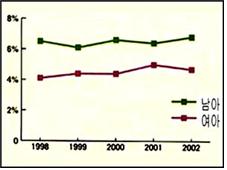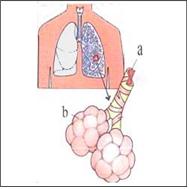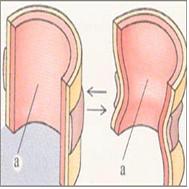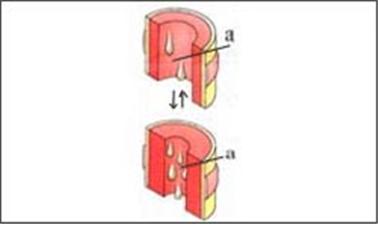천식(기관지 천식)의 개요, 역학, 여러가지 병명, 발작 기전 Definition, epidemiology, various names, mechanism of asthma(Bronchial asthma)
천식(기관지 천식)의 개요
- “기도는 폐 속에 나오는 공기와 폐 속으로 들어가는 공기의 통로“이다.
- 기도는 콧구멍에서 시작해서 비강, 인두강, 후두, 기관, 기관지, 세기관지까지의 호흡기 부분을 통 털어 기도라고 할 수 있다.
- 엄밀하게 따진다면 구강도 기도라고 할 수 있지만 구강은 소화기에 속한다.
- 천식은 그 기도의 만성 염증성 질환이며 변이성 질병(Variable disease)이라고 정의하기도 하며 유전성 호흡기 질환의 일종이다.
기도(Airways)가 외부에서 들어온 유발인자, 신체 내부 유발인자에 노출되면 다음 1~4와 같은 병변이 기도에 생기고 그에 따른 증상 징후가 공통적으로 생길 때 천식이라고 할 수 있다.
-
기관지가 여러 가지 유발 인자의 자극에 예민하게 반응되고
-
기관지가 수축되고 좁아지고
-
기관지 염증이 생기고 기관지 벽이 붓고 가래가 나오고
-
기침 및, 또는 호흡곤란 등의 증상 징후가 생길 수 있다.
천식(기관지 천식)의 발병률과 역학
-
천식은 신생아 영아 유아 학령기 전 아이, 학령기 아이, 사춘기 아이, 성인 모든 연령층에 있는 남녀노소 누구에게나 유발될 수 있다.
-
모든 연령층의 미국인들의 5%에게 천식이 유발되고,
-
전 미국인들의 8~12%에게 천식이 유발되고,
-
미국 소아들의 5~7%에게 천식이 유발되고,
-
미국 남아들의 10~15%, 여아들의 7~10%에게 천식이 유발된다.
-
-
알레르기 비염이 있는 아이들의 40%에서 천식이 유발된다.
-
천식을 앓았던 과거 병력이 있는 아이들 90%는 알레르기 비염을 앓을 수 있고, 일반적으로 알레르기 비염과 천식을 동시에 앓을 때 알레르기 비염이 치료되면 천식도 치료될 수 있어 상호 밀접한 관련이 있다.
-
천식의 병력이 있는 아이들 30%는 첫 돌 이전에 최초 천식 발작이 시작하고,
-
천식 병력이 있는 아이들의 80~90%는 4~5세 전부터 천식을 앓기 시작한다고 한다.
-
소아 천식의 대부분은 간헐 천식이다.
-
대부분의 간헐 천식은 잘 치료되나 드물게는 지속적 천식을 앓는 아이들도 있다.
-
천식을 앓는 아이들의 50%는 천식을 앓기 시작한 10~20년 이후 천식 발작이 더 이상 유발되지 않는다고 주장하는 의사들도 있지만 천식은 완전히 치료되지 않는 유전성 기도병이다.
-
일생 동안 어느 때든지 천식 발작 유발 인자에 노출되면 다시 천식 발작이 유발될 수 있는 기도 변이성 질병이다.
-
천식은 소아들에게서 보는 만성 호흡기 질환 중 가장 흔한 질환이다.
천식(기관지 천식)의 통계에 의하면
-
미국에서는 년 14.5 백만 명이 천식으로 병원에서 치료 받고
-
그 중 45만 명이 입원 치료를 받고 1~2백만 명이 응급 치료를 받고
-
1 천만 명 초중고 학생들이 천식으로 등교를 못하고
-
천식으로 연간 5천 명이 사망하고
-
2006년 미국에서 19.7억 불의 천식 진료비가 들었고
-
2006년 2천 2백만 여명의 미국 사람들이 천식을 앓았고,
-
2006년에 천식을 앓았던 2천 2백만 명의 미국 사람들 중 6.8백만 명이 18세 이하의 소아청소년들이었다.

그림 158. 0~17세 미국 아이들에게 발생되는 천식 %
National Health Interview Servey, Pediatric News. May 2005

그림 159. 소아 천식 발생률
National Health Interview Servey, Pediatric News. May 2005
천식(기관지 천식) 병명대신 다음 병명을 쓰기도 한다.
-
기관지천식(Bronchial asthma)
-
천식(Asthma)
-
천식성 기관지염(Asthmatic bronchitis)
-
감수반응 기도 병(Reactive airway disease)
-
예민 기도 병(Irritable airway disease)
-
색색거리면서 숨 쉬는 아이(Wheezy child)
-
만성 기관지염(Chronic bronchitis)
-
색색(쌕쌕)거리는 기관지염(Wheezy bronchitis)
-
바이러스 유발성 천명(Viral-associated wheezing)
-
아들에게 생긴 천식을 소아천식(Childhood asthma)
-
아토피 체질에 관련된 천식(Atopic related asthma)
-
알레르기성 천식(Allergy related asthma) 등 그 외 다른 병명을 붙이기도 한다.
기관지가 천식(기관지 천식) 발작 유발 인자에 접촉될 때
-
기관지 벽의 평활근이 수축되고,
-
기관지 벽에 염증과 부종이 생기고,
-
기관지 벽 점막층에서 점액이 기관지 속으로 분비되고,
-
그 결과로 기관지 부분 기도가 좁아지는 병변이 생기고,
-
기관지에 생긴 병변 정도는 천식의 종류, 중증도, 나이 등에 따라 다르고,
-
그런 병변이 자연적으로 일시적으로 회복될 수 있고 적절한 치료를 받으면 정상적 기도로 회복되는 것이 일반적이다.
-
치료를 적절히 하지 않으면 천식으로 생긴 기관지가 손상이 평생 동안 계속 남아 있을 수 있다.
-
천식 발작이 유발될 때 전체기도 중 기관지에만 병변이 생길 수 있고,
- 기관지에 생긴 병변과 거의 비슷한 병변이 후두에만 생길 수 있고,
- 기관에만 생길 수 있고,
- 기관지와 세기관지에만 생길 수 있고,
- 세기관지에만 생길 수 있고,
- 후두, 기관, 기관지, 세기관지 등 하기도 전체에 함께 생길 수 있다.
그림으로 본 천식(기관지 천식)의 발작 기전 그림 Ⅰ~Ⅶ
1. 천식 발작 기전 그림 Ⅰ

그림 6~1. 천식이 발작됐을 때의 기도의 횡단면 및 종단면의 그림.
a-후두, b-기관, c-기관지, d-세기관지(모세기관지), e-평활근, f-폐포, g-모세기관지 벽, h-기도 내 분비물 (가래)(그림 252와 동일)
- 육체적 운동이나 그 외 다른 종류의 천식 발작 유발인자로 기도가 수축될 수 있고 기도의 일부가 막힐 수 있다.
- 이때 기관지 확장제로 치료하면 정상적으로 기도가 되돌아갈 수 있다.
- 천식발작 유발로 기도염이 생길 수 있고 기도가 부을 수 있지만 천식 증상 징후가 거의 나타나지 않을 수 있고 때로는 나타날 수 있다.
- 이미 천식발작 유발인자로 기도염이 생겼을 때 거기에 또 다른 발작인자에 노출되면 기도염이 더 심해질 수 있고 기도가 더 붓고 점액분비가 더 증가되고 결과적으로 기도가 더 막힐 수 있다. 출처;Used with permission from Paul Sigh Roy 및 부모도 반의사가 되어야 한다–소아가정간호백과
2. 천식 발작의 기전 그림 Ⅱ

그림161. a-후두, b-기관, c-기관지, d-세기관지
출처: Used with permission from Hardy 1992 및 부모도 반의사가 되어야 한다–소아가정간호백과
3. 천식 발작의 기전 그림 Ⅲ

그림162. 정상 기도의 횡단 및 종단면도
a-모세기관지(세기관지), b-폐포
출처: Used with permission from Hardy 1992 및 부모도 반의사가 되어야 한다–소아가정간호백과

그림163. 좌: 정상 세기관지 횡단 및 종단면
우: 중등도 천식 세기관지 횡단 및 종단면도
② 경도 지속 천식이 발작될 때 기관지와 세기관지가 수축되어 기도 속이 좁아질 수 있다.
출처: Used with permission from Hardy 1992 및 부모도 반의사가 되어야 한다–소아가정간호백과
4. 중등도 지속 천식 Ⅳ

그림164. 지속 천식이 있는 기도의 횡단 및 종단면도.
중등도 지속 천식으로 기관지와 세기관지가 수축됐고 기도 내에 가래가 분비됐다(그림 상)
중증도 지속 천식으로 기관지와 세기관지가 심하게 수축됐고 기도 내에 가래가 분비됐고 기도의 벽이 부었다(그림 하)
출처: Used with permission from Hardy 1992 및 부모도 반의사가 되어야 한다–소아가정간호백과
5. 천식 발작 기전 그림 Ⅴ

그림 166. 천식 발작이 된 기도의 횡단도.
② 중등도 지속 천식이 발작될 때 기관지와 세기관지의 수축이 더 많이 되고 기도 속이 더 좁아지고 기도 내벽이 더 붓는다.
④ 중증도 지속 천식이 발작될 때는 기관지와 세기관지 부분의 기도가 더 수축되어 그 기도 속이 더 좁아지고 그 내벽이 더 붓고 염증이 더 생길 수 있다
출처;Used with permission from Paul Sigh Roy 및 부모도 반의사가 되어야 한다–소아가정간호 백과
6. 천식 발작 기전 그림 VI

그림 6~8. 천식 발작이 유발 됐을 때 기도의 변화와 기도의 횡단 그림
a-정상 기도(기관지), b-급성 기관지 수축, c-만성 천식으로 기도가 수축되고 기관지벽에 염증이 생겨 기도가 더 좁아진 것, d-아 급성 천식이나 만성 천식으로 기관지 벽이 붓고 거기에 염증이 생겨 기도가 더 좁아졌다. e-염증성 세포, m-비만세포에서 히스타민 과립체가 분비된다. m-T 세포, B 세포, 폐포 대식 세포(p), 호산구(o), 호중구 등이 활성화 되어 생긴 히스타민, 사이토카인, 류코트리엔, 프로스타글란딘 등 여러 가지 매개체가 생겨 그것들이 복합적으로 작용해 천식이 발작될 수 있다.
MBP; 주요 호염기구 세포독성 효소(호염기구 (Major basophilic protein)가 분비되고
PAF:혈소판활성화 인자(Platelet activating factor, PAF)
참조문헌-Asthma, The Pediatric Clinics of North America, December 1992, W. B. Saunders
-
천식 발작이 유발되는 기전을 어느 정도 잘 알려져 있지만 아직도 확실히 모르는 점도 많다.
-
천식을 앓을 수 있는 유전 인자를 타고날 때부터 지니고 있는 소아들이 천식 발작 유발 인자에 노출될 때 그 유발 인자에 의해 기관지 벽 평활근이 수축되고 그 부분의 기도가 비정상적으로 수축되고 좁아진다.
-
이런 현상을 기관지 수축 또는 기도 수축이라 한다.
-
천식이 발작되면, 기관지가 수축되는 동시에 기관지 벽이 붓고 그 벽에 염증이 생기고 기관지 속기도 내에 점액이 분비되고 그 결과로 기관지 속 기도부분이 더 좁아지게 된다. [부모도 반의사가 되어야한다–소아가정간호백과]-제8권 소아청소년 호흡기 질환–만성 기관지염 참조
Overview, epidemiology, epidemiology, various names, mechanism of asthma (Bronchial asthma) 천식(기관지 천식)의 개요, 역학, 여러가지 병명, 발작 기전
Overview of Asthma (bronchial asthma)
• “The airway is the passageway for air into and out of the lungs.”
• The airway can be called an airway, starting from the nostrils and covering the respiratory tract from the nasal cavity, pharynx, larynx, trachea, bronchi, and bronchi.
• Strictly speaking, the oral cavity can also be called an airway, but the oral cavity belongs to the digestive system.
Asthma is a chronic inflammatory disease of the airways, also defined as a variable disease, and is a type of hereditary respiratory disease. When the airways are exposed to an external trigger or a trigger inside the body, the following lesions 1 to 4 occur in the airways and the symptoms and signs are common.
• The bronchi are sensitive to stimulation of various triggers and
• bronchi constrict and narrow
• Inflammation of the bronchial tubes, swelling of the walls of the bronchial tubes, phlegm
• Symptoms may include coughing and/or shortness of breath.
Incidence and epidemiology of asthma (bronchial asthma)
• Asthma can be induced by newborns, infants, toddlers, preschoolers, school-age children, adolescents, and adults of all ages, men and women, of all ages.
o 5% of Americans of all ages cause asthma;
o Asthma causes 8 to 12% of all Americans;
o Asthma is induced in 5-7% of children in the United States;
o Asthma is induced in 10-15% of boys and 7-10% of girls in the United States.
• Asthma is induced in 40% of children with allergic rhinitis.
• 90% of children with a history of asthma can have allergic rhinitis, and when allergic rhinitis and asthma are co-existed, asthma can also be cured if allergic rhinitis is treated, which is closely related.
• 30% of children with a history of asthma have their first asthma attack before their first birthday;
• It is said that 80-90% of children with a history of asthma start having asthma before the age of 4 or 5 years.
• The majority of childhood asthma is intermittent asthma.
• Most intermittent asthma treats well, but some children rarely have persistent asthma.
• Asthma is a hereditary airway disease that is not completely cured, although some doctors claim that 50% of children with asthma no longer have asthma attacks 10 to 20 years after they start having asthma.
• An airway variable disease in which exposure to an asthma trigger at any time in a person’s life can trigger an asthma attack again.
• Asthma is the most common chronic respiratory disease seen in children.
According to the statistics of asthma (bronchial asthma)
• In the United States, 14.5 million people per year are treated in hospital for asthma
• Of those, 450,000 receive inpatient care and 1-2 million receive emergency care.
• 10 million elementary, middle and high school students are unable to attend school due to asthma
• Asthma kills 5,000 people annually
• $1.97 billion in asthma treatment costs in the United States in 2006;
• In 2006, 22 million Americans had asthma;
• Of the 22 million Americans who had asthma in 2006, 6.8 million were children under the age of 18.

Figure 158. Asthma % of children aged 0-17 in the United States National Health Interview Servey, Pediatric News. May 2005

Figure 159. Childhood asthma incidence National Health Interview Servey, Pediatric News. May 2005
Asthma (bronchial asthma) Instead of the disease name, the following disease name is sometimes used.
• Bronchial asthma
• Asthma
• Asthmatic bronchitis
• Reactive airway disease
• Irritable airway disease
• Wheezy child
• Chronic bronchitis
• Wheezy bronchitis
• Viral-associated wheezing
• Childhood asthma
• Atopic related asthma
• Other diseases, such as allergic asthma, are also given.
When the bronchi are in contact with triggers of asthma (bronchial asthma) attacks
• The smooth muscles of the bronchial wall contract,
• Inflammation and swelling of the bronchial walls,
• Mucus is secreted into the bronchi from the mucous membrane of the bronchial wall,
• The result is a lesion that narrows the airways of the bronchi,
• The degree of bronchial lesion varies depending on the type, severity, and age of asthma.
• Such lesions can spontaneously recover temporarily, and normal airways usually return with appropriate treatment.
• If left untreated, damage to the bronchial tubes caused by asthma can persist for life.
• When an asthma attack is triggered, only the bronchi of the entire airway may be lesioned,
o A lesion that is almost similar to a lesion in the bronchi can occur only in the larynx,
o can only occur in organs,
o It can occur only in the bronchi and bronchi,
o It can occur only in the bronchi,
o The larynx, trachea, bronchi, and bronchioles may occur together in the entire lower respiratory tract.
Attack of Mechanism of Asthma (bronchial asthma) as seen in pictures Figures Ⅰ~VII
- Asthma Attack Mechanism Figure I

Figure 6-1. Illustration of the cross-section and longitudinal section of the airway during an asthma attack. a – larynx, b – trachea, c – bronchi, d – bronchioles (capillaries), e – smooth muscle, f – alveoli, g – walls of the capillaries, h – endotracheal secretions (sputum) (same as Figure 252)
• Physical exercise or other types of asthma triggers can constrict the airways and block parts of the airways.
• If treated with a bronchodilator at this time, the airway can return to normal.
• Asthma triggers can lead to airway inflammation and swelling of the airways, but there may be few and sometimes no signs of asthma symptoms.
• If you have already developed airway inflammation as a trigger for asthma attacks, exposure to another triggering factor may worsen airway inflammation, increase airway swelling, increase mucus secretion, and consequently block airways. Source: Used with permission from Paul Sigh Roy and www.drleelpediatrics,com
2. Mechanism of asthma attack Figure Ⅱ

Figure 161. a – larynx, b – trachea, c – bronchi, d – bronchi Source: Used with permission from Hardy 1992 and www.drleepediatrics.com
3. Mechanism of asthma attack Figure Ⅲ

Figure 162. Transverse and Longitudinal Sections of Normal Airway a – capillaries (bronchioles), b – alveoli Source: Used with permission from Hardy 1992 and parents should also become anti-doctors – www.drleepediatrics.com

Figure 163. Left: Normal bronchiolar transverse and longitudinal section Right: Transverse and longitudinal section of bronchioles with moderate asthma.
② When mild persistent asthma attacks, the bronchi and bronchioles constrict and the airway may become narrow. Source: Used with permission from Hardy 1992 and parents should also become anti-doctors – Encyclopedia of Pediatric and Family Nursing
4. Moderate Persistent Asthma Ⅳ Figure

164. Transverse and longitudinal sections of airways with persistent asthma. With moderate persistent asthma, the bronchi and bronchioles constricted and sputum was secreted in the airways (shown in the figure). In severe persistent asthma, the bronchi and bronchioles were severely constricted, phlegm was secreted in the airways, and the walls of the airways were swollen (bottom picture). Source: Used with permission from Hardy 1992
5. Asthma Attack Mechanism Figure Ⅴ

Figure 166. Transverse view of an asthmatic airway.
② When moderate persistent asthma attacks, the bronchi and bronchioles constrict more, the airway becomes narrower, and the airway lining becomes more swollen. ④ When severe and persistent asthma attacks, the airways of the bronchi and bronchioles constrict more, making the airways narrower and the lining of the airways more swollen and inflamed Source: Used with permission from Paul Sigh Roy
6. Asthma Attack Mechanism Figure VI

Figure 6-8. Airway changes and airway cross-section when an asthma attack is triggered a-normal airways (bronchial tubes), b-acute bronchospasm, c-constriction of the airways with chronic asthma and narrowing of the airways due to inflammation of the bronchial walls, d-subacute or chronic asthma, with swelling of the bronchial walls Inflammation made the airways narrower. Histamine granules are secreted from e-inflammatory cells and m-mast cells. mT cells, B cells, alveolar macrophages (p), eosinophils
(o), neutrophils, etc. are activated and various mediators such as histamine, cytokines, leukotrienes, and prostaglandins are created, and they work together to cause asthma attacks . MBP; Major basophilic cytotoxic enzymes (Major basophilic protein) are secreted and PAF: Platelet activating factor (PAF)
REFERENCES—Asthma, The Pediatric Clinics of North America, December 1992, W. B. Saunders
• Although some of the mechanisms that trigger asthma attacks are well known, there are still many unknowns.
• When children who are born with a genetic factor for developing asthma are exposed to an asthma attack trigger, the bronchial wall smooth muscle contracts and the airway in that area abnormally constricts and narrows.
• This phenomenon is called bronchoconstriction or airway constriction.
• In an asthma attack, the bronchi constrict, while the walls of the bronchial tubes become inflamed and inflamed, and mucus is secreted into the bronchial airways, resulting in a narrower airway.
출처 및 참조 문헌 Sources and references
- NelsonTextbook of Pediatrics 22ND Ed
- The Harriet Lane Handbook 22ND Ed
- Growth and development of the children
- Red Book 32nd Ed 2021-2024
- Neonatal Resuscitation, American Academy Pediatrics
- www.drleepediatrics.com제8권 소아청소년 호흡기 질환
- www.drleepediatrics.com제9권 소아청소년 소화기 질환
- www.drleepediatrics.com제10권. 소아청소년 신장 비뇨 생식기 질환
- www.drleepediatrics.com제11권. 소아청소년 심장 혈관계 질환
- www.drleepediatrics.com제12권. 소아청소년 신경 정신 질환, 행동 수면 문제
- www.drleepediatrics.com제13권. 소아청소년 혈액, 림프, 종양 질환
- www.drleepediatrics.com제14권. 소아청소년 내분비, 유전, 염색체, 대사, 희귀병
- www.drleepediatrics.com제15권. 소아청소년 알레르기, 자가 면역질환
- Red book 29th-31st edition 2021
- Nelson Text Book of Pediatrics 19th — 21st Edition
- The Johns Hopkins Hospital, The Harriet Lane Handbook, 22nd edition
Copyright ⓒ 2015 John Sangwon Lee, MD., FAAP
“부모도 반의사가 되어야 한다”-내용은 여러분들의 의사로부터 얻은 정보와 진료를 대신할 수 없습니다.
“The information contained in this publication should not be used as a substitute for the medical care and advice of your doctor. There may be variations in treatment that your doctor may recommend based on individual facts and circumstances. “Parental education is the best medicine.”